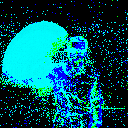Neuromorphic Datasets Processing¶
Authors: fangwei123456
spikingjelly.datasets provides frequently-used neuromorphic datasets, including N-MNIST 1, CIFAR10-DVS 2, DVS128 Gesture 3, NAV Gesture 4, ASLDVS 5, etc. In this tutorial, we will take DVS 128 Gesture dataset as an example to show how to use SpikingJelly to process neuromorphic datasets.
Download DVS128 Gesture¶
The DVS128 Gesture dataset can be downloaded from https://ibm.ent.box.com/s/3hiq58ww1pbbjrinh367ykfdf60xsfm8/folder/50167556794. The box website does not allow us to download data by python codes without login. Thus, the user have to download manually. Suppose we have downloaded the dataset into E:/datasets/DVS128Gesture, then the directory structure is
.
|-- DvsGesture.tar.gz
|-- LICENSE.txt
|-- README.txt
`-- gesture_mapping.csv
Get Events Data¶
Let us import DVS128 Gesture from SpikingJelly and create train/test set. We set use_frame=False to use Event data rather than frame data.
from spikingjelly.datasets import DVS128Gesture
root_dir = 'E:/datasets/DVS128Gesture'
train_set = DVS128Gesture(root_dir, train=True, use_frame=False)
test_set = DVS128Gesture(root_dir, train=True, use_frame=False)
SpikingJelly will do the followed work when running these codes:
Check whether the dataset exists. If the dataset exists, check MD5 to ensure the dataset is complete. Then SpikingJelly will extract the origin data into the
extractedfolderThe sample in DVS128 Gesture is the video which records one actor displayed different gestures under different illumination conditions. Hence, an AER sample contains many gestures and there is also a adjoint csv file to label the time stamp of each gesture. Hence, an AER sample is not a sample with one class but multi-classes. SpikingJelly will use multi-threads to cut and extract each gesture from these files.
Here are the terminal outputs:
DvsGesture.tar.gz already exists, check md5
C:/Users/fw/anaconda3/envs/pytorch-env/lib/site-packages/torchaudio/backend/utils.py:88: UserWarning: No audio backend is available.
warnings.warn('No audio backend is available.')
md5 checked, extracting...
mkdir E:/datasets/DVS128Gesture/events_npy
mkdir E:/datasets/DVS128Gesture/events_npy/train
mkdir E:/datasets/DVS128Gesture/events_npy/test
read events data from *.aedat and save to *.npy...
convert events data from aedat to numpy format.
thread 0 start
thread 1 start
thread 2 start
thread 3 start
thread 4 start
thread 5 start
thread 6 start
thread 7 start
0%| | 0/122 [00:00<?, ?it/s]working thread: [0, 1, 2, 3, 4, 5, 6, 7]
finished thread: []
We have to wait for a moment because the cutting and extracting is very slow. A events_npy folder will be created and contain the train/test set:
|-- events_npy
| |-- test
| `-- train
Print a sample:
x, y = train_set[0]
print('event', x)
print('label', y)
The output is:
event {'t': array([172843814, 172843824, 172843829, ..., 179442748, 179442763,
179442789]), 'x': array([ 54, 59, 53, ..., 36, 118, 118]), 'y': array([116, 113, 92, ..., 102, 80, 83]), 'p': array([0, 1, 1, ..., 0, 1, 1])}
label 9
where x is a dictionary with keys ['t', 'x', 'y', 'p'];``y`` is the label of the sample. Note that the classes number of DVS128 Gesture is 11.
Get Frames Data¶
The event-to-frame integrating method for pre-processing neuromorphic datasets is widely used. We use the same method from 6 in SpikingJelly. Data in neuromorphic datasets are in the formulation of \(E(x_{i}, y_{i}, t_{i}, p_{i})\) that represent the event’s coordinate, time and polarity. We split the event’s number \(N\) into \(T\) slices with nearly the same number of events in each slice and integrate events to frames. Note that \(T\) is also the simulating time-step. Denote a two channels frame as \(F(j)\) and a pixel at \((p, x, y)\) as \(F(j, p, x, y)\), the pixel value is integrated from the events data whose indices are between \(j_{l}\) and \(j_{r}\):
where \(\lfloor \cdot \rfloor\) is the floor operation, \(\mathcal{I}_{p, x, y}(p_{i}, x_{i}, y_{i})\) is an indicator function and it equals 1 only when \((p, x, y) = (p_{i}, x_{i}, y_{i})\).
SpikingJelly will integrate events to frames when running the followed codes:
train_set = DVS128Gesture(root_dir, train=True, use_frame=True, frames_num=20, split_by='number', normalization=None)
test_set = DVS128Gesture(root_dir, train=True, use_frame=True, frames_num=20, split_by='number', normalization=None)
The outputs from the terminal are:
npy format events data root E:/datasets/DVS128Gesture/events_npy/train, E:/datasets/DVS128Gesture/events_npy/test already exists
mkdir E:/datasets/DVS128Gesture/frames_num_20_split_by_number_normalization_None, E:/datasets/DVS128Gesture/frames_num_20_split_by_number_normalization_None/train, E:/datasets/DVS128Gesture/frames_num_20_split_by_number_normalization_None/test.
creating frames data..
thread 0 start, processing files index: 0 : 294.
thread 1 start, processing files index: 294 : 588.
thread 2 start, processing files index: 588 : 882.
thread 4 start, processing files index: 882 : 1176.
thread 0 finished.
thread 1 finished.
thread 2 finished.
thread 3 finished.
thread 0 start, processing files index: 0 : 72.
thread 1 start, processing files index: 72 : 144.
thread 2 start, processing files index: 144 : 216.
thread 4 start, processing files index: 216 : 288.
thread 0 finished.
thread 1 finished.
thread 2 finished.
thread 3 finished.
A frames_num_20_split_by_number_normalization_None folder will be created and contain the Frame data.
Print a sample:
x, y = train_set[0]
x, y = train_set[0]
print('frame shape', x.shape)
print('label', y)
The output is:
frame shape torch.Size([20, 2, 128, 128])
label 9
Let us visualize a sample:
from torchvision import transforms
from matplotlib import pyplot as plt
x, y = train_set[5]
to_img = transforms.ToPILImage()
img_tensor = torch.zeros([x.shape[0], 3, x.shape[2], x.shape[3]])
img_tensor[:, 1] = x[:, 0]
img_tensor[:, 2] = x[:, 1]
for t in range(img_tensor.shape[0]):
print(t)
plt.imshow(to_img(img_tensor[t]))
plt.pause(0.01)
We will get the images like:

- 1
Orchard, Garrick, et al. “Converting Static Image Datasets to Spiking Neuromorphic Datasets Using Saccades.” Frontiers in Neuroscience, vol. 9, 2015, pp. 437–437.
- 2
Li, Hongmin, et al. “CIFAR10-DVS: An Event-Stream Dataset for Object Classification.” Frontiers in Neuroscience, vol. 11, 2017, pp. 309–309.
- 3
Amir, Arnon, et al. “A Low Power, Fully Event-Based Gesture Recognition System.” 2017 IEEE Conference on Computer Vision and Pattern Recognition (CVPR), 2017, pp. 7388–7397.
Maro, Jean-Matthieu, et al. “Event-Based Visual Gesture Recognition with Background Suppression Running on a Smart-Phone.” 2019 14th IEEE International Conference on Automatic Face & Gesture Recognition (FG 2019), 2019, p. 1.
- 5
Bi, Yin, et al. “Graph-Based Object Classification for Neuromorphic Vision Sensing.” 2019 IEEE/CVF International Conference on Computer Vision (ICCV), 2019, pp. 491–501.
- 6
Fang, Wei, et al. “Incorporating Learnable Membrane Time Constant to Enhance Learning of Spiking Neural Networks.” ArXiv: Neural and Evolutionary Computing, 2020.